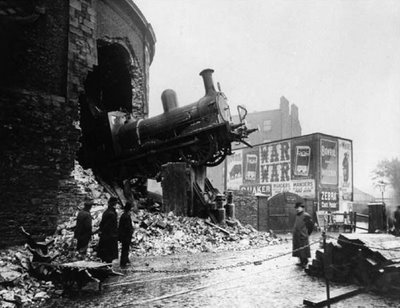
“Woe is us, said Mercier, we’re in the slow and easy.”
Samuel Beckett, Mercier and Camier, p.39
Turning the page on the calender to the last month of the year, I’m presented with an image of the last train to leave Dublin’s famous Harcourt Street line, at 4.25pm on New Year’s Eve 1958. A detail strikes me. I’m surprised how small the station staff are. I mean, they’re tiny. Not quite Lilliputian, but the average height seems to be no more than about 5’ 2”…
As a regular traveller on the Harcourt Street line in his early years, Beckett made many references to it throughout his writing. Eoin O’ Brien, in his book The Beckett Country, relates how, ‘In the Harcourt Street terminus, it was the staff who gave the place its character –
Watt bumped into a porter wheeling a milkcan. Watt fell and his hat and bags were scattered…
The devil raise a hump on you, said the porter.
He was a handsome if dirty fellow. It is so difficult for railway porters to keep sweet and clean, with the work they have to do.” Watt, p.22
And the newsagent Evans merits detailed description, not only because of his saturnine temperament, but for his ability to master a bicycle despite deformity. A talent not unusual in the Beckettian character –
He seemed a man of more than usual acerbity, and to suffer from unremitting mental, moral and perhaps even physical pain … but one thought of him as the man who, among other things, never left off his cap, a plain blue cloth cap, with a peak and knob. For he never left off his bicycle-clips either. These were a kind that caused his trouser-ends to stick out wide, on either side. He was short and limped dreadfully. When he got started he moved rapidly, in a series of aborted genuflexions.
Watt p.23-24
One passenger, Mercier, was not at ease on the ‘Slow and Easy’ –
You remain strangely calm, said Mercier. Am I right in thinking you took advantage of my condition to substitute this hearse for the express we agreed on ? Mercier and Camier, p.41
His pessimism was not unfounded. Some extraordinary events had befallen the locomotives of the Dublin and South Eastern Railway. In 1900 the up-train went too far and crashed through the end-wall of Harcourt Street station. Some twenty years later ‘somebody, from sheer wantonness, set an engine going just outside the station. Full of the joy of liberty, it puffed forth. For ages it had longed for an excuse to get away from those shining tracks – anywhere, anywhere, off these black tracks – it pointed and flung itself wildly into an astonished backyard somewhere in Albert Place’.

Beckett’s sadness at finding the station closed on a visit to Dublin is reflected in the poignant voice of That Time –
No getting out to it that way so what next no question of asking not another word to the living as long as you lived so foot it up in the end to the station bowed half double get out to it that way all closed down and boarded up Doric terminus of the Great Southern and Eastern all closed down and the colonnade crumbling away so what next That Time, p.231’
If Beckett were alive today, he could look forward to travelling this line again, as it will be re-opened to run one line of the Luas tram system. What would he make of the contemporary environment and its characters, surrounded by mobiles trilling like canaries in a tropical aviary. Disembodied, one-sided conversations, the IV drip-feed of iPod insulated passengers. The title of his prose work, Texts For Nothing could read like an ad for free text messages…
Googling “Harcourt Street line” I come across a curiosity from a discussion forum called p45.net:
Blather, High Priest of Ambiguity says:
Heard a mad story yesterday from someone, who heard it from a builder who's worked on sites in the area. Here's the story she was told:
'The Harcourt line was built across a fairy fort. When the station was being built, they had to bring in workers from Donegal, because none of the Dublin lads would work on the site. When the line was eventually running, the train drivers used to hoot the horn just before arriving in the station, to warn the fairies, and to avoid pissing them off. One day, a driver forgot to hoot, and the train crashed - the famous Harcourt crash. The Luas is now running on the same bit of track. The stretch of line is supposed to be haunted between Harcourt Street station and the canal.'
It seems quite fitting that the music venue, Tripod, situated at the Harcourt Street site, will, this coming Sunday, host a band who wrote a song called Outside The Trains Don’t Run On Time. Even more fitting as the construction of the Luas has certainly not run on time - not by a long shot. 'Slow and Easy' indeed !

1 comment:
Innit.
Post a Comment